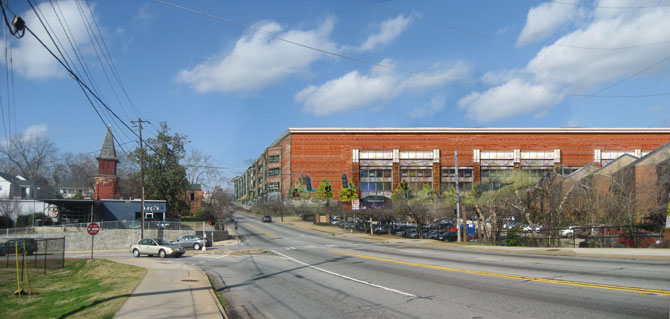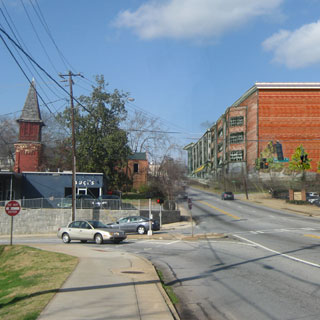
Compared with either Russell Edwards’ rendering or Selig’s, this view of Selig’s proposed development from Oconee Street, produced by highly qualified local design professionals from elevation drawings made available by Selig, looks pretty accurate. See m
Among the many frustrating components of the local discourse regarding Selig Enterprises’ proposal for the development of the Armstrong & Dobbs property has been a deeply counterproductive fracturing of Athens’ progressive community, which is as unnecessary as it is unfortunate. It’s easy to understand, given the range of competing priorities in play, but if we can stop arguing for a moment and think through the actual issues presented by the project, there’s no reason why we can’t find common ground to work together for a version of it that protects downtown and other surrounding neighborhoods and corridors, keeps Selig in the game and makes the city we all love better.
First, though, the resistance to Selig’s plan has to be put in its proper context. Russell Edwards’ “People for a Better Athens” initiative, while its mobilization of concerned citizens has been indispensable, has also been clumsy in its communications and occasionally reckless in its tactics, to the undeniable detriment of the conversation at large. But the Athens Banner-Herald and other outspoken supporters of the development have repeatedly passed off salvos from Selig’s painstakingly and professionally strategized public relations campaign as objective truth, especially when they have professed to be countering objections to the project, which are usually framed as the claims of “anti-Walmart activists” or a fringe “crowd.”
Whatever one thinks of Edwards’ admittedly amateurish, monolithic “yellow box” rendering, Selig’s equally dashed-off responding vision of an unobtrusive continuation of the low Oconee streetscape (published in the ABH alongside a story headlined “Misleading downtown Athens Walmart images circulate online,” which was clearly meant to refer only to Edwards’ rendering) doesn’t provide a passively factual counterpoint to it. And whether or not one is concerned about the percentage of the 17,000-plus signees to Edwards’ petition who don’t currently live in Athens, which Selig’s PR firm once claimed to be as high as 40 percent (a figure that also included obviously fake signatures, most of which have now been purged from the list), the more than 10,000 residents of this city that would remain even after that highly questionable calculation do not constitute an insignificant groundswell of opposition to this project as it is currently planned.
There are a few things most if not all of us can agree on. Athens is in bad need of sales and property tax revenue, as well as jobs; the center of the city is home to a large population of people in poverty who need those jobs, as well as easy access to affordable groceries; and the Armstrong & Dobbs property isn’t doing anyone much good as a semi-vacant lot. Most would also agree that Walmart is not the ideal retailer or employer to solve poverty in Athens; that there are good reasons why the city has made it a priority to protect and promote its central districts as its most valuable, marketable and investment-worthy assets; and that there are significant infrastructural issues to be reckoned with when considering a development of this size in the center of a town like ours.
We can talk about Walmart until we’re blue in the face, but there’s nothing our local government can or should do to stop an “objectionable” brand from doing business here. Likewise, any official policies designed to protect existing downtown and/or local businesses—much as we may value them—would be difficult to enact, and probably unwise, too.
Still, we do have recourse to our laws regarding planning and land use, and the narrative that this project is fully in compliance with all of those—pushed by Selig as part of its public relations campaign and repeated unquestioned by the Athens Banner-Herald and many others—is patently false. In addition to the simple fact that no site plans have yet been submitted to the ACC Planning Department for review, the project’s design also plainly ignores the requirement that right-of-way be preserved through the tract for a planned extension of Hickory Street that will provide a vital transit connection between the Multi-Modal Center and the UGA campus (see this week’s Athens Rising for more on that). There’s a point of view that says business should be conducted under any circumstances that are remotely allowed by the loosest interpretation of the law, but it’s hard to imagine that a majority of Athenians agree with it. This community will still have a chance to weigh in on how the development is executed.
The most important question to be answered is whether a 94,000-square-foot retail center is a use that is compatible with this location, and the simple answer is “no.” Town centers are not designed to support this kind of use; that’s why big-box stores are always located well outside of them. Oconee Street can’t handle the traffic a Walmart supercenter would add to it, nor can East Broad Street on the other side, nor Broad Street downtown, nor Wilkerson and the other neighborhood streets that would become funnels for coming and going shoppers. The investments our community has made in this exact area to help it grow as a walkable extension of downtown would be badly compromised by a development that is so obviously designed as a vehicular destination.
If our zoning code doesn’t prohibit such a blatantly inappropriate use of this site, “too bad for Athens” is not the proper response. Instead, our elected representatives, using every ounce of leverage they can muster, ought to sit down with Selig and tell them that, while we are delighted with their willingness to invest in our community and will work to accommodate that investment by whatever means possible, a big-box supercenter is not a use that can be considered for this location. Selig has said that Walmart is the only retailer that was interested in becoming the tenant of the “anchor” space as it has been designed; that is a very different thing from saying that no retailer would be interested in a smaller space. But we’ll never find out whether there are other possibilities if we don’t press the issue, and commissioners should do just that.
They should, but they probably won’t: there’s been little indication that the will exists on the commission to impose any meaningful limits on what Selig can do with this development. That means the issue must be pressed through other channels, like convincing Walmart, which is sensitive to its reputation as it pursues an agenda of placing its various smaller-sized “markets” in urban locations, that opening a store that would so negatively impact Athens’ iconic downtown would be a public relations disaster. To that end, some of Athens’ most prominent citizens are about to enter the conversation in a manner that should draw plenty of attention to the situation. The Drive-By Truckers’ Patterson Hood has written a song about what’s happening here, “After It’s Gone,” that has been recorded by the Truckers with members of R.E.M., Widespread Panic, Futurebirds and a bunch of other Athens musicians. It’ll be released by midnight Wednesday, Feb. 1 (that’s Tuesday night) at www.protectdowntownathens.com. The website has been set up to function as a clearinghouse for information about the development that cuts through the Selig PR with in-depth research and sober, professional analysis.
The idea that we have to choose between Selig’s current plan and leaving the valuable A&D property unused is a fallacy: there’s too much money in the location for it to go undeveloped even if Selig were to pull out. It’s sincerely to be hoped that they won’t, and that instead they will be convinced to revise the project’s design to make it compatible with its immediate surroundings and beneficial to the city as a whole. The current design would be neither, and to settle for it as though there were no alternatives would be an act of panic, and a mistake with consequences far more lasting than the political heat that comes from demanding private accountability to the public good.
Like what you just read? Support Flagpole by making a donation today. Every dollar you give helps fund our ongoing mission to provide Athens with quality, independent journalism.










